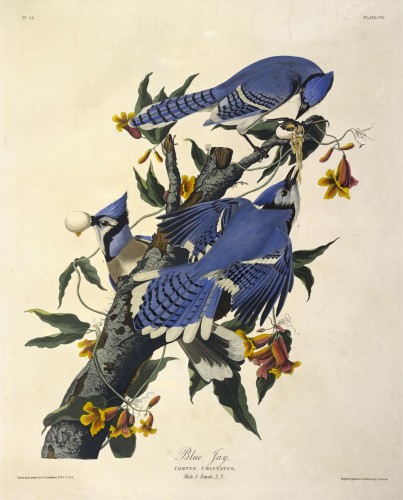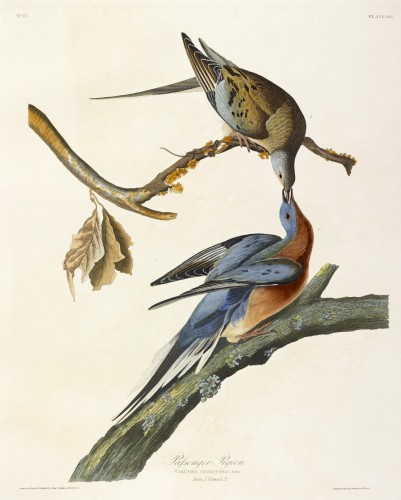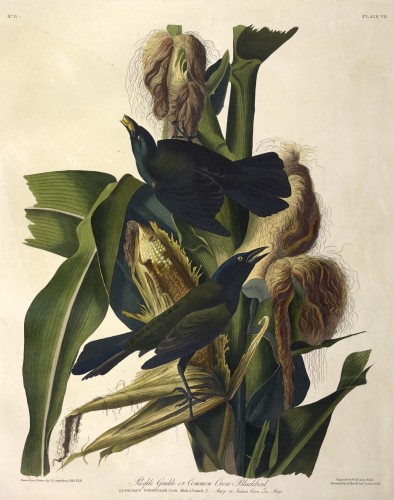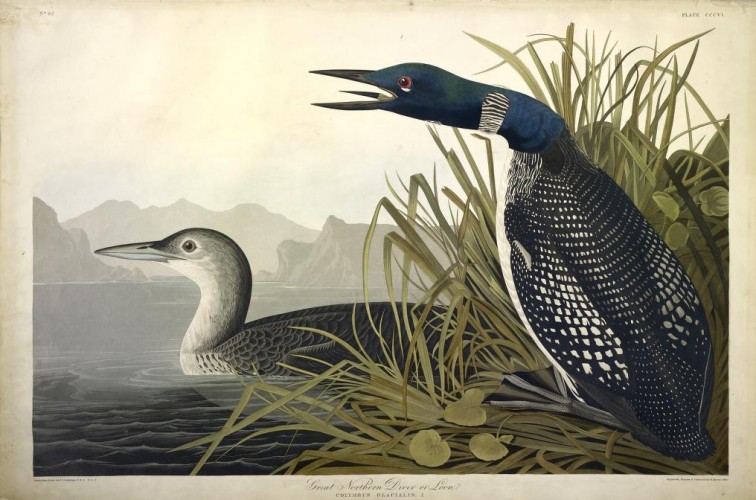Although the University of Michigan was founded in 1817, it was not until the University re-located to Ann Arbor in the late 1830s that the University began working towards the establishment of a University Library. The first “official” purchase for the library was made in February 1838, just a few months before Asa Gray set out on his European book-buying voyage.
Fitting the University’s aspirations for its future, this first acquisition was one of the most ambitious publications of the early 19th century: John James Audubon’s The Birds of America. Published in double Elephant Folio format (almost 40 inches tall) between 1827-1838, this work includes 435 plates containing 457 avian species (1,065 individual birds) in life-size hand-colored engravings. Encompassing as many known species as possible, his work ranges from giants who barely fit onto the 38” tall like the Wild Turkey and the Flamingo, to groupings of tiny songbirds and hummingbirds. Audubon’s publication was a masterpiece of artistry combined with scientific observation.

Blue Jay, Corvus Cristatus. (Plate CII) by John James Audubon from The Birds of America (1827-1838).
John James Audubon was born in Haiti in 1785 as Jean Rabine, son of Jeanne Rabin, mistress of French seacaptain and planter Jean Audubon. When he was six years old, Audubon was taken to France, where he was adopted by the elder Audubon and his wife, and grew up in his father’s household. Only at the age of eighteen did he journey to the United States when he was sent to his parents’ plantation in Pennsylvania, where his illigetimacy could be concealed. From 1803 to 1826, he spent much of his time studying and sketching the natural world. According to legend, the idea of publishing his work was the result of an 1810 encounter with Scottish ornithologist Alexander Wilson. Reportedly, Wilson offered to sell Audubon a copy of his own collection of American birds, American Ornithology; or the Natural History of Birds of the United States (1808-1814). Realizing that his own drawings were superior, Audubon embarked on a decades-long journey towards the publication of his own Birds of America.
Audubon’s images are noted for their life-like poses and realistic detail (down to the point of precise feather patterns). This is in part due to the method he developed for capturing near-life motion: he often drew his birds freshly-killed, pinned to a wall grid, as if in flight. He painted in watercolor, adding pastel, crayon, and chalk over certain areas to provide a feathery texture, and a glaze elsewhere to provide extra sheen. In general, he did not draw the backgrounds for his avian portraits, instead hiring other artists to fill in those areas.

Passenger Pigeon, Columba Migratoria, Linn. (Plate LXII) by John James Audubon from The Birds of America (1827-1838).
Unable to find a publisher in Philadelphia, Audubon traveled to the UK in 1826, where he met Scottish printer and engraver William Home Lizars of Edinburgh, who agreed to publish the first number of the work. The plan was to issue the plates in sets of five: 1 large (full plate), 1 medium (about ¾ page), and 3 small (½ page). Audubon’s original drawings were reproduced for publication primarily by etching, with some use of engraving and aquatint. All were finished by hand in watercolor. When Lizars' colorers went on strike in the summer of 1827, Audubon moved production of his masterpiece to Robert Havell and Robert Havell Jr. of London. In total, 175 completed sets of The Birds of America were delivered to subscribers.
The University of Michigan’s copy was purchased from William A. Colman of the City of New York, to whom a check for $970 was forwarded in April of 1839. The price paid would be approximately equivalent to $23,000 in today’s currency, but complete sets now sell for much more. In 2014, a set of The Birds of America sold at Sotheby’s for more than three million dollars. Conservation Librarian Emerita Cathy Baker, who has made an extensive study of Audubon’s work, believes that Colman most likely purchased the plates making up U-M’s set either directly from Audubon or from his publisher, the Havells.

Purple Grakle or Common Crow Blackbird, Quiscalus Versicolor, Vieill. (Plate VII) by John James Audubon from The Birds of America (1827-1838).
For many decades, these volumes were on display on the main floor of the library, where they were well-used and well-loved, judging from the number of smudges and fingerprints accrued during this time. Around 1915, The Birds of America was moved into the newly-created Rare Book Room, for a greater level of protection. In 1933-34, it was re-bound from four to eight volumes, under the supervision of William C. hollands, then in charge of the University’s printing and binding department. Today, we display one volume at a time in the Audubon Room, adjacent to the Hatcher Gallery, where visitors can enjoy a different plate each week.
Bibliography:
Baker, Cathleen. Audubon’s The Birds of America: A Technical Examination and Condition Survey of the Four-volume Folio Set Belonging to Syracuse University (Ann Arbor, MI: The Legacy Press, 2009). Special Collections Library QL 674 .A92 B35 2009.
John James Audubon: Drawn from Nature. Directed by Lawrence Hott/ 2007. New York: Eagle Rock Entertainment, WNET Chanel 13.

Great Northern Diver or Loon, Colymbus Glacialis, L. (Plate CCCVI) by John James Audubon from The Birds of America (1827-1838).